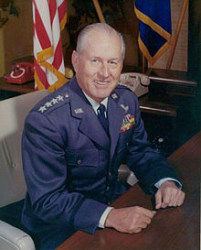
 |
|
|
||
|
Thomas Sarsfield Power |
||||
|
Engagements: • World War II (1941 - 1945) |
||||
| Biography: | ||||
|
Thomas Sarsfield Power Thomas Sarsfield Power was born in New York City on 18 June 1905. He attended Barnard Preparatory School in New York and entered the U.S. Army Air Corps flying school on 17 February 1928. He was commissioned a Second Lieutenant in February 1929. Power's early service included assignments at most of the famed Air Corps fields of the day: Chanute Field, IL, as a student officer; Langley Field, VA, as Commanding Officer of the 2d Wing Headquarters Detachment; Bolling Field, Washington, DC, for duty as an Army Air Mail Operations Pilot; Randolph Field, TX, as a flying instructor; Maxwell Field, AL, to attend the Air Corps Tactical School; and completing his early career as Engineering and Armament Officer at Nichols Field, Philippines. World War II During World War II, Power first saw combat while flying B-24 missions with the 304th Bomb Wing in North Africa and Italy. Returning to the U.S. in August 1944, he was named Commander of the 314th Bomb Wing (Very Heavy) and moved his B-29s to Guam as part of the 21st Bomber Command. On 9 March 1945, Power led and directed the first large-scale fire bomb raid on Tokyo, Japan, from Guam. General Carl Spaatz, then Commanding General of the U.S. Strategic Air Forces in the Pacific, moved Power up on his staff as Deputy Chief of Operations on 1 August 1945. He served in this capacity during the atomic bomb attacks on Hiroshima and Nagasaki. The Cold War Years During Operation Crossroads, the atomic bomb tests at Bikini Atoll in 1946, Power was assigned as Assistant Deputy Task Force Commander for Air on Admiral William H. P. Blandy's staff. Then came assignments as Deputy Assistant Chief of Air Staff for Operations in Washington; and a period of Air Attaché duty in London. In 1948, he was assigned as Vice Commander of the Strategic Air Command. During the next six years, Lieutenant General Power assisted General Curtis E. Lemay, then Commander-in-Chief of the Strategic Air Command, in building up SAC. In 1954, he was appointed Commander of the Air Research and Development Command, a position he held for three years. When General LeMay was named Vice Chief of Staff of the Air Force in 1957, Power became Commander-in-Chief of SAC and was promoted to the four-star rank of General. But although Power was LeMay's protégé, LeMay was quoted as privately saying that Power was mentally "unstable" and a "sadist." When RAND proposed a counterforce strategy that required SAC to restrain itself from striking Soviet cities in the beginning of a war, Power countered with: "Restraint? Why are you so concerned with saving their lives? The whole idea is to kill the bastards. At the end of the war if there are two Americans and one Russian left alive, we win!" During the Cuban Missile Crisis, Power purportedly raised the U.S. Defense Condition to "DefCon 2" (one step short of total nuclear war) and, according to some, without Presidential approval. Power also took the unprecedented action of broadcasting an alert message to global Strategic Air Command (SAC) nuclear forces in "the clear" (meaning on non-scrambled, open radio channels) in order to accomplish two objectives: 1) Alert all U.S. forces of the possibility of impending global nuclear war; 2) alert the Soviet Union that SAC was fully prepared and on standby to deploy nuclear weapons, if called upon to do so by the President. The Soviets immediately began the process of the removal of the nearly-activated nuclear missiles in Cuba after the broadcast, and while U.S. President John F. Kennedy and Attorney General Robert F. Kennedy struggled while continuing to pursue negotiation over weak diplomatic telecommunications channels before the implementation of the Moscow-Washington hotline. Like his mentor, General LeMay, Power believed that the only effective form of war strategy against enemy nations run by dictators in possession of nuclear weapons was Mutually Assured Destruction (MAD). Power continued supervision of this strategy, both in the development and deployment of the necessary weaponry, and the willingness to use these weapons in case of impending threat. Like LeMay, Power emphasized the value of bomber aircraft, which (unlike missiles) can be recalled in the event of an error in technical threat detection, and offer a strategic recourse short of total war. Power retired from the Air Force on 30 November 1964. He was America's last general officer without a post-secondary education. Medals and Awards Distinguished Service Medal General Power was a rated Command Pilot and Aircraft Observer. Popular Culture Power, a confirmed and unapologetic proponent of the LeMay school of staunch and successful militaristic anti-communism, was cartooned to create the "General Ripper" character in the film Dr. Strangelove or: How I Learned to Stop Worrying and Love the Bomb. Death and Burial General Thomas Sarsfield Power died on 6 December 1970. He is buried at Arlington National Cemetery in Arlington, VA, in Section 30, Lot 396 RH. His wife, Mae A. Power, was buried next to her husband after her death in 1985. |
||||
| Honoree ID: 814 | Created by: MHOH | |||
Ribbons
Medals
Badges
Honoree Photos
 |  |  |
 |  |
 |


